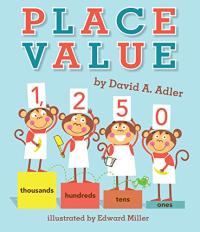
Young Rosie wants nothing more than to invent, to be an engineer. Her confidence is shaken until her great-aunt Rosie (strongly echoing Rosie the Riveter of WWII fame) helps restore it. Told in rhyme with verve and humorous illustrations, this story is sure to inspire and engage.
Rosie Revere, Engineer

Iggy Peck loves to build anything using almost any material. His teacher, however, disagrees about architecture. Iggy rises to the challenge and changes her mind in this rhyming, thoroughly satisfying tale of an aspiring (and inspired) young architect.
Iggy Peck, Architect

Ada Twist constantly asks questions: what, why, where? Her parents tire of it until they realize that Ada Twist is really a budding scientist! Told in rollicking rhyme and playful, style-conscious illustrations, this engaging tale is satisfying as well as inspiring.
Ada Twist, Scientist

They live in prairies, they’re very important to the environment but these dogs wouldn’t make good pets. Meet prairie dogs in this handsomely illustrated, lively, and informative book told in a familiar cadence with music and additional resources included.
Prairie Dog Song: The Key to Saving North America’s Grasslands

These thorough explorations of what dogs see, how and why they behave, and more is sure to engage both canine aficionados as well as young scientists. The narrative is lucid, clear and appealing. Index, additional resources, and table of content complete the package.
Inside of a Dog: What Dogs See, Smell, and Know

Hopper’s new school, Stately Academy, is more creepy than scholarly as the 12-year-old girl soon learns. But with her new friends, they discover the school’s secrets and address them through computer coding. The adventures of this multicultural cast of kids continue in Paths and Portals (opens in a new window) as the series goes on.
Secret Coders

People have always been fascinated by the moon. Since Galileo, humans have walked on the moon, created stronger telescopes and more. The historical and current examination of Earth’s closest neighbor is presented in a generously illustrated, very handsome, and comprehensible package.
Our Moon: New Discoveries About Earth’s Closest Companion

Regardless of where they live, camouflage helps protect animals. Cut-paper collage and short poems introduce a variety of insects and animals that fly, swim, and live on land or in water. Poetry is short, rhythmic, and appealing followed by additional information and further resources.
Now You See Them, Now You Don’t: Poems about Creatures That Hide

Scientists thought the coelacanth had been extinct for about 65 million years when one was caught off the South African coast in 1938. This is a fascinating examination of “living fossils”, plants or animals that are close to their ancient relatives. Each is presented “then” and “now” in detailed, realistic paintings and readable text. Additional resources conclude this fascinating book.
Living Fossils: Clues to the Past

Whether they’re fish or fungi, these creatures share the ability to create their own light or glow. Most live in deep seas but some – like fireflies – are easily seen on land particularly at dusk. Two volumes present information about bioluminescent animals in amazing photographs and lucid text.
Way to Glow! Amazing Creatures that Light Up in the Dark

Why be afraid of the dark when there is so much to see? Whether it’s used to hunt, hide, find a friend, or escape an enemy, bioluminescence—the ability to glow—is a unique adaptation in nature. In this fun and fascinating nonfiction picture book, join world-renowned photographers and biologists on their close encounters with the curious creatures that make their own light.
Glow: Animals with Their Own Nightlights

“Each animal has its own special way of seeing.” Clear, close-up photographs of animals’ eyes and the question posed in the title are followed by more information about other animals. A variety of animals appear, from owls and pigeons to alligators and frogs. Information about the human eye concludes this fascinating look at ways of seeing.
Whose Eye Am I?

What does jumping on a trampoline have to do with science? Lots, it turns out! The basic physics laws involved are presented in crisp, readable text and action-packed photographs. For readers interested in ecology, Arctic Food Chains (Pogo: Who Eats What?) by Rebecca Pettiford (Jump! 1620314274) is similarly formatted and quite interesting (with just a hint of blood in the photographs). Table of contents, index and additional resources for each title expands the use.
Trampolines

When a couple complains about pigeons in the park, two children in pigeon costumes come to give them the real story about pigeons. Done in an open comic book format, this easier-to-read book is sure to entertain as well as inform.
The Real Poop on Pigeons

In this playful introduction to number values, readers are reminded that “Order is important in both words and numbers.” Cheerful monkeys, chefs from the Banana Café, host this exploration making place values from one to upwards of a trillion understandable and relatable.
Place Value

Loggerhead turtles are confused by artificial lights on the beach. A group of children work to turn them out so that turtle hatchlings can follow the moon to the sea. The story of how children became activists and can continue to contribute positively is engagingly presented. Suggestions conclude this attractive, can-do book.
Follow the Moon Home

A colony of penguins, a pod of whales, a formation of rocks, and other groups of animate and inanimate things bring a lonely child to his own group. The joyful reunion creates a family. Stylized illustrations are rich with humor and liveliness, deserving of many readings.
There Is a Tribe of Kids

A walking octopus? A swimming elephant? A flying snake? Yes! Animals move in varied, unexpected ways. Stunning collage illustrations and informative text present a range of animals and how they move. Additional information about where these animals live is included.
Flying Frogs and Walking Fish

Look at some of the amazing animals found near or in the ocean in colorful, sometimes sparkly illustration. Lift the flap; touch the texture to find out a bit more about them in this sturdy, appealing, and informative, surprisingly sophisticated book.
Touch and Explore the Ocean

Don’t toss that tube, use it to create! Clearly presented ideas for crafts, games and other activities are displayed in this well organized, accessible book – a creative way to recycle and reuse “trash.”
Junk Re-Thunk

Air is all around us and is crucial to all living things on earth. In poetic language and handsome photographs of people from around the globe, the importance of clean air is presented. Additional information is presented at the back of the book.
Every Breath We Take: A Book About Air

Kathy Sullivan followed her dreams regardless of what other girls did. She learned to pilot a plane as a teenager and as an adult, an astronaut and the first woman to walk in space. Her early experiences are juxtaposed to her work as an astronaut on alternating spreads seen in attractive illustrations and a crisp text. A note from Sullivan (coauthor of the book) as well as brief sketches of other women astronauts concludes this fascinating book.
To the Stars: The First American Woman to Walk in Space

What do these 17 animals — from tarantulas to blobfish to seahorse and with lots in between — share in common? Each one is pink! An amazing array of pink animals is presented in image and text to inform, intrigue, and inspire. Additional information is included.
Pink Is for Blobfish

Readers may never look at a science fair in the same way after reading this alphabetical introduction to one school’s effort. From “Anti-matter” to “Zero gravity” (and of course, an animated z for zucchini) real and imagined inventions (differentiated in an endnote) and science concepts are presented. Cartoon illustrations and speech bubbles are used in this silly romp.
